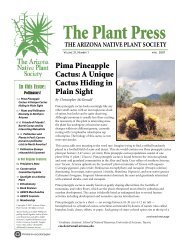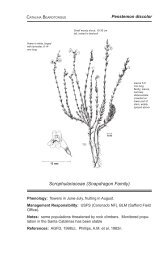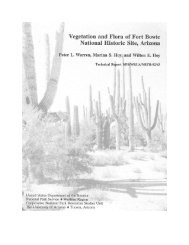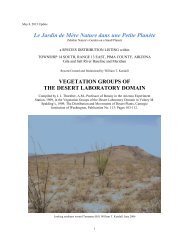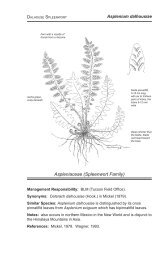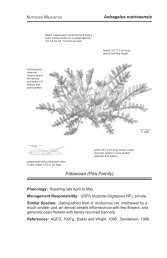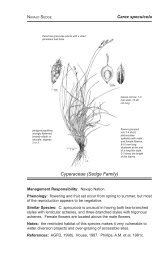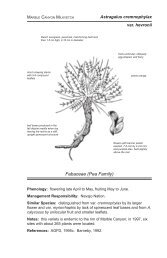T14S.R13E Pima County.AZ 050813 - Arizona Native Plant Society
T14S.R13E Pima County.AZ 050813 - Arizona Native Plant Society
T14S.R13E Pima County.AZ 050813 - Arizona Native Plant Society
Create successful ePaper yourself
Turn your PDF publications into a flip-book with our unique Google optimized e-Paper software.
applied to other species and to the genus Aristida); Triple-awned Beard Grass (a name also applied to other species and to thegenus Aristida); Triple-awned Beard-grass (a name also applied to other species and to the genus Aristida); Zacate Cola de Zorra(Spanish); Zacate de Semilla (Spanish); Zacate Tres Barbas (a name also applied to other species and to the genus Aristida,Spanish); 6-Weeks 3-Awn. DESCRIPTION: Terrestrial annual tufted graminoid (ascending to erect culms 1¼ to 40 inches inheight); the color of the foliage has been described as being bright green, purple or yellow curing to straw; the florets may bepurple, purplish or red-purple; flowering may take place year-round between early January and late December; the seed headsmay be purple. HABITAT: Within the range of this species it has been reported from rocky mountains; mountaintops;mountainsides; bedrock, rocky, rocky-sandy-loamy, gravelly-sandy-clayey and sandy mesas; plateaus; rocky canyons; rocky andsandy canyon bottoms; rocky gorges; talus slopes; crevices in rocks; shallow pockets of soil; buttes; rocky ledges; rocky ridges;rocky ridgetops; meadows; foothills; rocky and sandy hills; rocky-gravelly and gravelly hilltops; rocky hillsides; escarpments;sandy bases of escarpments; bedrock, bouldery, bouldery-sandy, rocky, rocky-gravelly, rocky-clayey, stony, stony-clayey,gravelly, gravelly-sandy, gravelly-loamy, gravelly-clayey, gravelly-clayey-loamy, sandy, sandy-clayey, sandy-clayey-loamy,sandy-silty, clayey and clayey-loamy slopes; rocky alluvial fans; gravelly-sandy bajadas; rocky outcrops; amongst boulders androcks; sandy lava flows; sand hills; sandy dunes; sandy-loamy prairies; gravelly-sandy, sandy and clayey-loamy plains; rocky,rocky-sandy, gravelly, gravelly-loamy, gravelly-sandy-loamy, sandy, sandy-loamy and sandy-clayey-loamy flats; valley bottoms;along rocky railroad right-of-ways; along roadbeds; gravelly roadcuts; along rocky, rocky-gravelly, rocky-sandy, rocky-clayeyloamy,gravelly, gravelly-sandy, gravelly-loamy, sandy and sandy-loamy roadsides; along sandy arroyos; rocky draws; ravines;seeps; silty springs; along streams; streambeds; along creeks; creekbeds; along rivers; sandy riverbeds; along and in rocky, rockysandy,cobbly-pebbly-sandy, gravelly, gravelly-sandy and sandy washes; bedrock drainages; within rocky drainage ways; siltydepressions; swales; banks of draws; along (rocky) edges of washes; along margins of washes; mudflats; sandy benches; shelves;terraces; bottomlands; floodplains; ditches; gravelly-sandy riparian areas; sandy waste places, and disturbed areas growing in drydesert pavement; bouldery, bouldery-sandy, rocky, rocky-gravelly, rocky-pebbly, rocky-sandy, shaley, stony, cobbly-pebblysandy,gravelly, gravelly-sandy and sandy ground; rocky loam, rocky-gravelly loam, rocky-sandy loam, rocky-clayey loam,gravelly loam, gravelly-sandy loam, gravelly-clayey loam, sandy loam, sandy-clayey loam, clayey loam and silty loam ground;rocky clay, stony clay, gravelly clay, gravelly-sandy clay, sandy clay and clay ground, and gravelly-sandy silty, sandy silty andsilty ground, occurring from below sea level to 12,700 feet in elevation in the forest, woodland, scrub, grassland, desertscrub andwetland ecological formations. NOTES: This plant may be an attractive component of a restored native habitat. This plant maybe confused with Aristida purpurea var. parishii. Aristida adscensionis is native to south-central and southern North America;Central America; South America, and other tropic, sub-tropic and warm-temperate regions of the world. *5, 6, 15, 16, 33 (Page242), 43 (080109), 44 (032611 - color presentation including habitat), 46 (Page 120), 58, 63 (081709 - color presentation), 77, 85(100811 - color presentation of dried material), 89 (reported as being a summer annual herb located on the Mesa-like MountainSlopes, recorded as Aristida americana (Kunth) Griseb.), 105, 124 (032611), 140 (Pages 197 & 298)*Aristida americana (see footnote 89 under Aristida adscensionis)Aristida divaricata F.W. von Humboldt & A.J. Bonpland ex C.L. von Wildenow: Poverty ThreeawnCOMMON NAMES: Divaricate Aristida; Poverty Three Awn; Poverty Three-awn (a name also applied to otherspecies); Poverty Three-awn Grass; Poverty Threeawn; Poverty Threeawn Grass; Spreading Triple-awn Grass; Spreading TripleawnedGrass. DESCRIPTION: Terrestrial perennial tufted graminoid (a bunchgrass with 7 to 40 inches in height, one plant wasdescribed as being 40 inches in height and 4 inches in width at the base); the foliage is dark green curing to straw; floweringgenerally takes place between early June and late October (additional records: one for mid-February, two for mid-November andone for late November). HABITAT: Within the range of this species it has been reported from mountains; gravelly-sandy andsandy mesas; cliffs; canyons; rocky canyon walls; crevices in rocks; knolls; ridges; ridgetops; meadows; foothills; rocky hills;sandy hilltops; rocky hillsides; rocky, rocky-gravelly-clayey, gravelly, gravelly-sandy, gravelly-loamy, gravelly-clayey-loamy,sandy, sandy-loamy, sandy-clayey and clayey slopes; sandy bajadas; rocky outcrops; cindery sides of craters; bouldery-cinderylava flows; gravelly-sandy and sandy plains; llanos; rocky, sandy-loamy and clayey flats; valley floors; valley bottoms; alonggravelly and gravelly-loamy roadsides; rocky draws; along streams; creekbeds; riverbeds; within washes; sink-holes; (clayey)banks of washes; along (gravelly-sandy) edges of ponds and lakes; cobbly-clayey, sandy and clayey benches; terraces, anddisturbed areas growing in dry bouldery-cindery, rocky, cindery, gravelly, gravelly-sandy and sandy ground; rocky loam, rockyclayeyloam, gravelly loam, gravelly-clayey loam, sandy loam and loam ground, and rocky-gravelly clay, cobbly clay, sandy clayand clay ground, occurring from 400 to 8,600 feet in elevation in the forest, woodland, scrub, grassland, desertscrub and wetlandecological formations. NOTES: This plant may be an attractive component of a restored native habitat. This plant was reportedto have been utilized by native peoples of North America; it was noted as having been used as a drug or medication. This plant isclosely related to Aristida barbata. Aristida divaricata is native to southwest-central and southern North America and CentralAmerica. *5, 6, 30, 33 (Page 236), 43 (081709), 44 (100811), 46 (Page 120), 63 (081709), 85 (100811 - color presentation ofdried material), 89 (reported as being a perennial herb located on Tumamoc Hill, recorded as Aristida humboldtiana Trin. &Rupr.), 105, 124 (100811), 127*Aristida divergens (see footnote 89 under Aristida ternipes)Aristida glauca (see Aristida purpurea var. nealleyi)28



